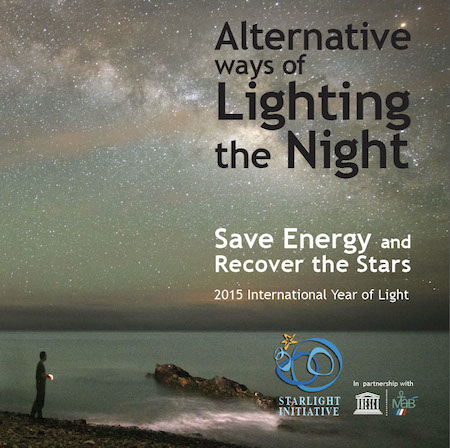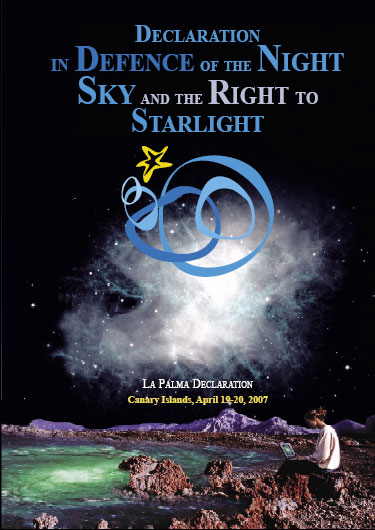Flyer - Starlight Initiative in partnership with the UNESCO MAB Programme
Alternative ways of Lighting the Night: Save Energy and Recover the Stars!
 On the ocassion of International Year of Light (IYL2015)
On the ocassion of International Year of Light (IYL2015)
Light and the climate
Sustainable lighting and climate change
The over-illumination has become a growing phenomenon in many towns and cities around the world. Excess of artificial light increases energy consumption and is economically unjustified. It also increases the level of emissions that contribute to climate change. By contrast, today more than 1.3 billion people worldwide do not have access to basic electricity
Light and the stars
Recovering our vision of the starry sky
At present most people in the world do not have the possibility to see the Milky Way and its stars in the sky, including astronomers. The increase in light pollution is blotting out the stars from our sky, causing the deterioration of a legacy with strong cultural, scientific, environmental and aesthetic repercussions. Clear night skies also provide sustainable income opportunities as tourists and visitors are eagerly looking for sites with impressive night skies.
Light and life
Protecting biodiversity and people’s health
Light pollution also has a negative effect on many species of plants and animals, including migratory species, both in protected areas and in urban or rural areas. Too much light can affect people’s health, by changing circadian rhythms. Thus, reducing the emission of artificial light may help to protect biodiversity and improve health conditions for the general population.
Solutions
Promoting outdoor lighting with intelligent options
This would be based around three simple principles. First, only illuminate what needs to be illuminated. Second, make use of outdoor lighting only when needed. Finally, use luminaires that completely avoid light emissions towards the horizon or up to the sky. It is absurd to waste energy sending light to the stars.
Innovation
New opportunities for lighting technology
At present, eco-efficient technologies exist that make it possible to limit light pollution: luminaires, sensors, flux and time regulators, motion detectors as well as new generations of lamps. It is also possible to use more efficient lamps that do not emit wavelengths that are harmful to the environment, avoiding the use of white light, including white LEDs.
Biosphere Reserves, Towards a New Culture of Light
Reducing light pollution and recovering starry sky should be part of a new culture of biosphere reserves protection committed to acting on climate change and sustainable development. Eight years after the Declaration of La Palma (Declaration in Defence of the Night Sky and the Right to Starlight), over twenty biosphere reserves have now developed successful initiatives to ensure night sky quality and promote sustainable lighting.
Download Flyer
(*)Texts: Cipriano Marín (Starlight Initiative) & Peter Dogse (UNESCO MaB Secretariat)
| < Prev | Next > |
|---|
LOOKING FOR SOMETHING?


Starlight Initiative collaborates with the
PORTAL TO THE HERITAGE OF ASTRONOMYUpdates
- The New World Atlas of Light Pollution - Paperback
- Starlight, beyond light pollution - La Palma 2016
- New Brochure of UNESCO`s MAB Programme partnership
- Galicia adopts the Starlight Declaration
- Starlight at the 39th session of the World Heritage Committee
- International declaration warning about the effects of blue-rich white light
- Flyer - Starlight Initiative in partnership with the UNESCO MAB Programme
- Astronomical Heritage - Hawaii 2015
Starlight Finder
Starlight related links
![]()
Covenant of Mayors Related Initiative
![]()
Colaborating with IAU Working Group
![]()
IUCN Dark Sky Advisory Group
![]()
Dark Skies Awareness Project
![]()
Partnership Unesco-MaB
![]()
Member of the Knowledge Network
![]()
Instituto de Astrofísica de Canarias
|
The Starlight Initiative is designed as an international action in defence of the values associated with the night sky and the general right to observe the stars. It is open to the participation of all scientific, cultural, environmental, and citizens' organizations... |
In partnership with: |
|
|
|


